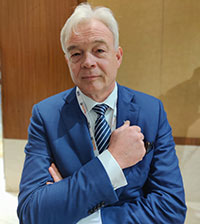 Alexander, the Reinach, Switzerland-based diversified provider of dyes and specialty chemicals, serves the branded and performance textiles, packaging and paper, and coatings, adhesives and sealants markets globally. The leading company operates a highly integrated, customer-focused platform that delivers specialized performance and color solutions in over 100 countries. With 3,000 employees spread over 35 countries and 26 production sites the company has created a niche in its space. Alexander Wessels, CEO, Archroma speaks to Fashionating World in an exclusive interview and elaborates on the company’s operations, products and sustainability in the dyestuff industry.
Alexander, the Reinach, Switzerland-based diversified provider of dyes and specialty chemicals, serves the branded and performance textiles, packaging and paper, and coatings, adhesives and sealants markets globally. The leading company operates a highly integrated, customer-focused platform that delivers specialized performance and color solutions in over 100 countries. With 3,000 employees spread over 35 countries and 26 production sites the company has created a niche in its space. Alexander Wessels, CEO, Archroma speaks to Fashionating World in an exclusive interview and elaborates on the company’s operations, products and sustainability in the dyestuff industry.
Tell us more about Archroma?
Archroma is the largest supplier of chemical and dyes to the global textile and paper industries. We are a major advocator of sustainability and drive the efficiency of our natural resources which enables us to reduce production costs.
What is the USP of your products?
We invest a massive amount of capital in sustainable processes. Besides, we scientifically map new methods to optimise our process and devise new sources of dyeing. Our dyes are made from natural waste from the color red. Though many other suppliers make similar things but they neither have the required scientific back up nor do they invest much in new solutions.
Have you been able to convince everyone that sustainability and cost are not mutually exclusive?
Yes, we have. Archroma has made these investments to help manufacturers across the world. The use of our machines is growing globally. In Bangladesh, the market share of our systems has grown from 6-7 per cent to 40-50 per cent. We use advanced technologies that reduces the usage of fiber and energy driving down overall manufacturing cost.
Which country leads in sustainability? Where is India positioned?
I don’t think any particular part of the world is more sustainable than the other. It is more related to individual brands. Brands like Patagonia, Adidas make consistent investments in sustainability. India too has the potential to be the leader in sustainability if it invests more in aspects like technology, production, etc. It can also lead in cotton recycling and be a sustainable user of cotton.
Fashion is perceived as the second most polluting industry after fossil fuels. Please Comment?
That is not the case. Fuels, agriculture and energy are known to be more polluting than textiles. The carbon dioxide emissions from the textile industry result in only 6 per cent of global emissions. Though the industry uses a lot of water particularly in water pressured areas like Bangladesh, Pakistan, India, some parts of China, we have introduced solutions that help save water. For example, technologies used in denim dyeing save around 90 per cent of water.
However, most products still consume a lot of water. Why?
This is the responsibility of the entire industry. To address this, brands need to start selling eco-friendly apparels instead of cheap clothing. They need to provide good value for product. There are also a couple of corporate initiatives like sustainable peril coalition that we are committed to. However, there is still a lot to be done on different levels to become more sustainable. The current government’s Make in India initiative enables us to capture this fast.
With a slowdown, customers are not willing to pay beyond a certain amount for apparels. Does this affect your capacity to innovate?
Though ongoing trade wars are not stimulating global growth, they are providing opportunities to countries like India and China to increase domestic demand. India is likely to become a bigger consumer market than Europe in the next 10 to 20 years. So, we need to take these challenges as an opportunity to grow.
With global supply chains rebalancing, re-shifting and restructuring, where do you see Asia and particularly India, Bangladesh in this context?
In the short term, Vietnam, Bangladesh, India will profit from whatever is happening. However, in the long term, if this regional trade blocks continue, trade on the global level it will be restricted and be more localised. Asia will be the largest consumer market in the next few years and actually overtake every other continent. India and Bangladesh are really well positioned to take advantage of these situations given that they do not engage in any trade war what so ever.
As for reshoring, with changing landscapes the paradigm of manufacturing is also changing. Will it take away from Asia?
Of course, digitalisation will lead to different business modules where individualization will be possible and maybe within 10 years you can actually sit behind your computer to completely design your jeans yourself, maybe five years and two days later it is on your door post. That will certainly emerge as a part of the market, of course for the mass market there is no module.
How optimistic are you about overall growth because the GDP has dropped down to 3 per cent which is the worst in last 10 years?
Though many countries are going through a recession, there are signs of growth in some. We don’t predict the future of a company on the basis of a short recessionary cycle. We look for long term outlook.
At the micro level, how do you see apparel and textile industry, stacked up and growth going forward?
I am too remote to make a forecast on the domestic level. But, internationally the key is to stay competitive. Superior quality, good traceability and good sustainability will drive the industry forward.
What is your message as a global citizen?
Firstly, it is important for us to realise that it is not only about a green portion but taking big steps to make this industry truly sustainable. Our traders have solutions for complete circularity. There is no mass market or would never be mass market but I think every step if they take toward making their natural resources better, we should do and we are obliged to our children to do so and I think everyone in the textile industry who denies it is not worthy to be a leader.












